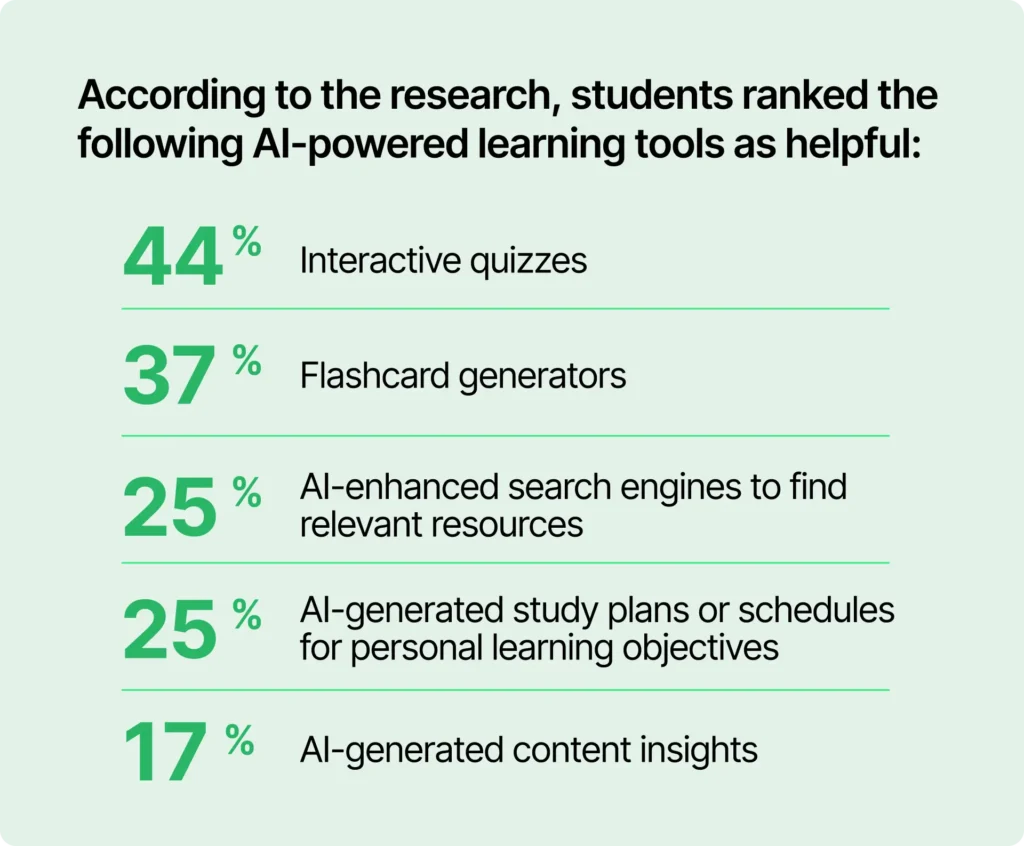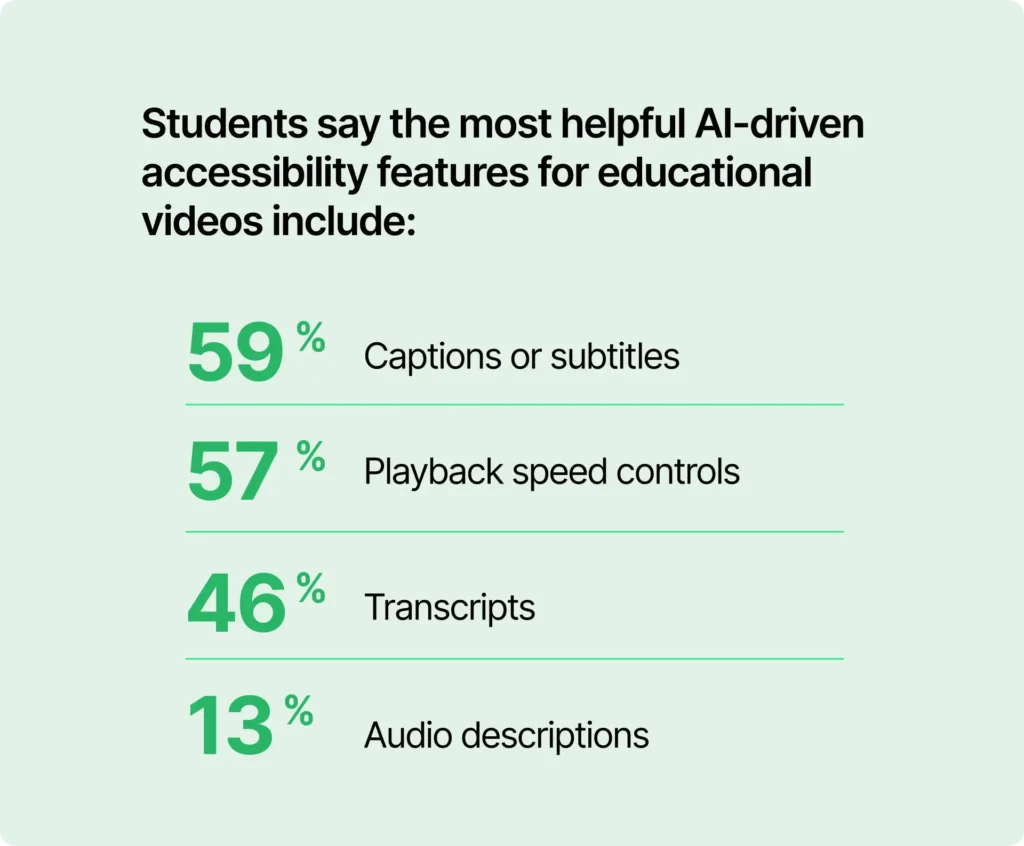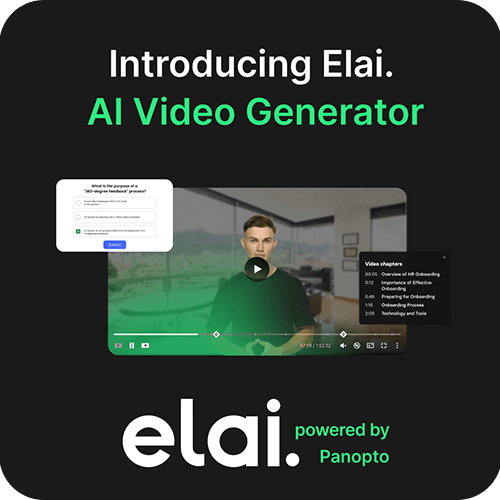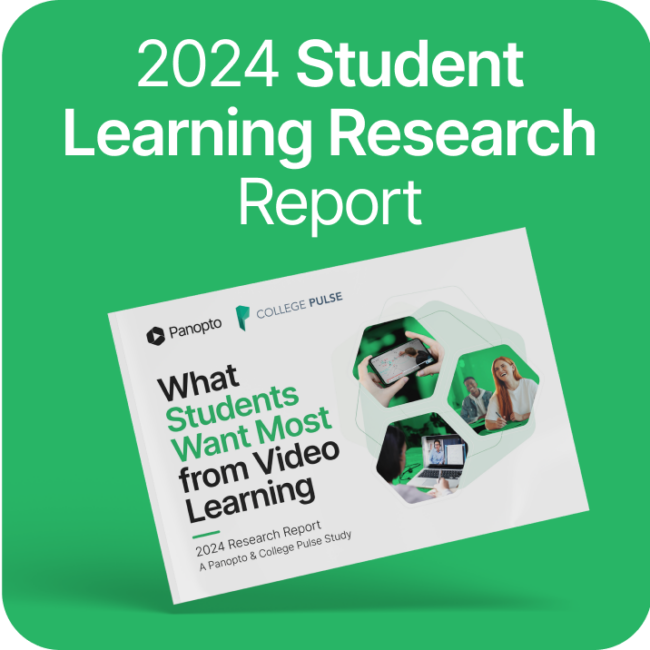- Higher Education
Uncovering Student Perceptions of AI in Education

Artificial intelligence (AI) is changing education, including how we teach and learn. One study showed that 22% of U.S. higher education faculty use AI in education. While institutions everywhere test new tools, coach faculty on best practices, and develop ethical guidelines for AI usage, the result is clear: AI in education is here to stay.
Listening to what students think about AI
To navigate change, your students’ voices matter most as a higher education leader or administrator. As colleges and universities decide how to manage AI tools in education, they must work to understand student perceptions of AI tools to inform their approaches.
Today, AI has several uses in education beyond generative and content creation. Understanding student perspectives may guide institutions in implementing policies aligned with student preferences.
Surveying Students on AI in Education
Recently, Panopto published a research study showing that college students trust AI across wide categories of digital learning environments and interactions. The data comes from 1500+ United States institutions from the College Pulse student panel. Here’s a breakdown of how students feel about AI tools impacting their learning experience.
AI in education can personalize learning.
AI can make learning in digital environments more personal. Panopto research shows that 63% of college students trust AI to make personalized learning recommendations for content. And another 59% trust AI to alert them of things they’ve missed.
For example, if a student watches an online lecture from a class session they couldn’t attend, an AI tool might recommend another video or online resource mentioned by the professor. It might also suggest relevant YouTube videos or articles that further explain concepts explored in the lecture or additional lectures by the same professor or on similar topics.

The future of personalized learning with AI seems bright. It can facilitate personal student interactions in the digital learning environment and guide personal study plans. Our latest research suggests that students seem to trust it, too.
Learning with chatbots.
AI chatbots offer additional ways to personalize students’ digital experiences. Today’s students are accustomed to getting support on campus, and chatbots can answer questions and direct students to the resources they need at any time.
Our research found that 25% of college students said chatbot tutors or virtual assistants helped answer their questions in real-time.
In addition to providing answers about educational programs and individual courses, chatbots can further students’ education by providing instant feedback on assignments and study materials or tracking progress.
What Students Want Most from Video Learning
Creating content with generative AI.
Generative AI tools like ChatGPT may concern higher education leaders, and new guidelines will be developed and reassessed continuously. It might be reassuring to know then that students remain skeptical about generative AI content tools. Of all the AI tasks in our survey ranked by students, they were least likely to trust generative AI to generate accurate content (48%). A study by Forbes also noted that 41% of students say they always edit AI-generated content, while 3% stated they never do.
Students’ awareness of generative AI’s potential inaccuracies and drawbacks can be an important touchpoint for educators and administrators looking to align implementation policies. Because of the growing importance of generative AI in education and the workplace, training students to use the tools ethically could be a valuable starting point.
Tracking video transcripts.
When students watch course videos, such as recorded lectures, AI offers another valuable study aid: automated video captioning and transcription. These features may have been initially designed for accessibility, but today’s students universally value them across campus. For example, 31% of students say automated video transcripts are helpful for their learning, and 28% percent say AI-powered video summaries are helpful.
Panopto offers automated video captioning and transcription in more than 20 global languages so students can access educational content in the words they know best. AI-generated captions, descriptions, and transcripts make it easier for the entire student body to interact with online content.

With Panopto Access AI, higher education institutions can easily plug into AI to personalize each learner’s experience and enhance comprehension, increasing engagement and achievement. The new product add-on uses AI to generate high-level summaries that help users navigate video libraries and easily select content relevant to their learning. Users can access in-depth video summaries to review the content and strengthen retention when they select a video. Administrators can also turn on automatic multi-language translation and captioning to scale accessible learning across campus. AI-powered transcripts highlight important concepts and help users follow along as material is presented.
Learn About Panopto AI in Education
Panopto’s AI-powered video learning platform scales accessible learning off campus for 1650+ global educational institutions. With transcriptions and captioning for 20+ languages, AI-powered keyword search to help learners find content quickly, and automatic workflows for translating video content, Panopto scales video learning with an easy-to-use platform purpose-built for education.
Latest Blogs
-

- Presentations
How to Use a PowerPoint Screen Recorder to Capture Presentations on Video
A PowerPoint screen recorder has become an indispensable tool for professionals who want to transform static presentations into dynamic, shareable video experiences. Gone are the days when compelling presentations were confined to conference rooms or live webinars. Today’s knowledge workers need versatile ways to capture, share, and preserve their insights. Whether you’re an educator bridging…
How to Use a PowerPoint Screen Recorder to Capture Presentations on Video
-

- Video Learning
Transforming High-Potential Development Programs with Video-Based Learning Solutions
High-potential development programs are the cornerstone of sustainable organizational growth—yet most fail to deliver on their promise, leaving future leaders frustrated and companies vulnerable to talent drain. The conventional approach of sporadic workshops, limited mentorship, and one-size-fits-all training continues to produce disappointing results: knowledge gaps, inconsistent skill development, and ultimately, the departure of your most…
Transforming High-Potential Development Programs with Video-Based Learning Solutions
-

- Onboarding
Sales Onboarding Strategies and Guide
Sales onboarding forms the critical foundation of your entire revenue generation strategy. It’s more than just showing new hires where the coffee machine is and handing them a product catalog. Sales onboarding is all about transforming promising talent into confident, knowledgeable revenue drivers as quickly and effectively as possible. What separates world-class sales organizations from…
Sales Onboarding Strategies and Guide



